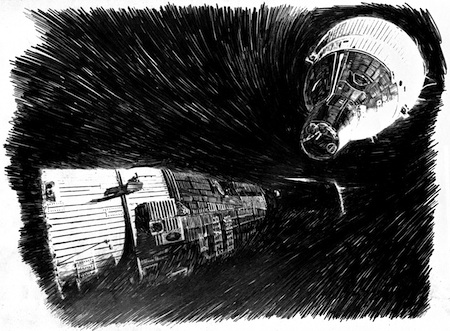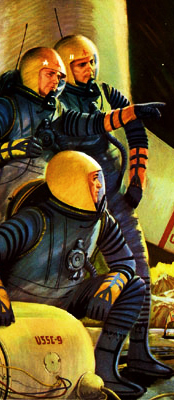The great space artist Paul Calle died yesterday at age 82. As a NASA artist he documented the early space program with a rare mix of passion and precision. With works like the portrayal of the first space rendezvous shown above, Paul captured as no one else the excitement of that incredible time. I was fortunate to have known him and to have enjoyed his warmth, wit, and tremendous spirit. Here is the introduction I wrote for an collection of his Apollo works, published last year.
You don’t usually know years ahead of time that the most incredible event of your life is coming up. But if you grew up in the 1960s and you were a space nut, you knew. I remember thinking sometime around the summer of 1966 that there were less than four years to go until Apollo astronauts would be walking on the moon. In the summer of 1966 I was ten years old, and nothing mattered more to me than the space program. (Okay, the space program and the Beatles.) The missions of Project Gemini, NASA’s “bridge to the moon,” were going strong. Astronauts were walking in space, and doing space rendezvous, and staying in orbit for a week or even two weeks at a time. I couldn’t have asked for a better time to be a kid.
And the best part was the pictures. If the latest issue of LIFE or National Geographic arrived and it had a new set of space photos, the rest of the family didn’t get to see it very much, because I had it. I stared at the images from space, letting them transport me into a realm of black skies and brilliant sunlight, of white spacesuits and mirrored visors, of spaceships afloat in the void, with the Earth’s bright panorama beyond. But there was one thing those pictures could never do: They couldn’t document the feeling of that incredible time. They couldn’t record what it was like to be alive when humans were taking their first steps into an endless frontier, seeing what no one had ever seen, doing what had never been done. For that, we needed Paul Calle.
When I first encountered his work, in a NASA booklet on the Gemini missions that came out in 1966, I was immediately hooked. I had never seen anyone draw the way Paul did, with those bold pencil strokes defining shape and movement, capturing men and machines with uncanny realism. In his rendering of Gemini 6 and 7, nose-to-nose in history’s first space rendezvous, I could almost feel the blinding intensity of the unfiltered sunlight of outer space. And when he portrayed Gemini 7’s Frank Borman and Jim Lovell just back from their record-breaking, two-week space marathon, I sensed the mix of exhaustion and exhilaration that they must have felt as they stood on the deck of the aircraft carrier, bearded and weak-legged, savoring their triumph.
And it wasn’t just the astronauts I saw; it was the life force of everyone who sent them into space, from the engineers who created their magnificent flying machines to the orbital-mechanics wizards who figured out how two spacecraft traveling at 17,500 miles per hour could fly to within a foot of each other. Somehow, Paul’s vivid line work transmitted the electrifying excitement of the entire adventure; even the void of space seemed to vibrate with some kind of fantastic energy, like iron filings tracing the contours of a magnetic field. In those days, with the endless frontier opening up before us, it was almost impossible not to feel swept along by that same magnetic power, pulling you into a spectacular tomorrow. After all, we were going to the moon.
And when the day of that ultimate voyage finally arrived in the summer of 1969—the summer of Apollo—it was like the entire world stopped in its tracks to witness it. On that muggy July morning, as Neil Armstrong, Mike Collins, and Buzz Aldrin ate their last meal on Earth and put on their spacesuits, I was glued to the television. I could not have known that Paul Calle was there, with the three men who were about to leave the planet, quietly capturing his own unique pen-and-ink snapshots of the moment. But the next day, when I was poring over the coverage of the mission in the paper, I came to a full-page ad for one of the TV networks, featuring Paul’s superb pencil drawing of the first human footstep on another world—an event still hidden in the unknowable future, now only a few days away, but rendered as if it had already happened. And in the mind of Paul Calle, it had.




{ 1 comment… read it below or add one }
Way back in my high school days (too long ago), I received the hardback version of “Apollo Expeditions To The Moon” for a birthday present (I still have it). One of the chapters highlighted the work of artists who documented the effort. I remember being enthralled with the work of Paul Calle (and others) who seemed to capture the feeling of a scene better than a photograph could.
Like Andrew, nothing in those days captured my imagination more than the space program (not even the Beatles). Paul’s work will remain an integral part of those memories. And while I sad at his passing, I rejoice that he was with us during these times — leaving an indelible mark in a remarkable period.